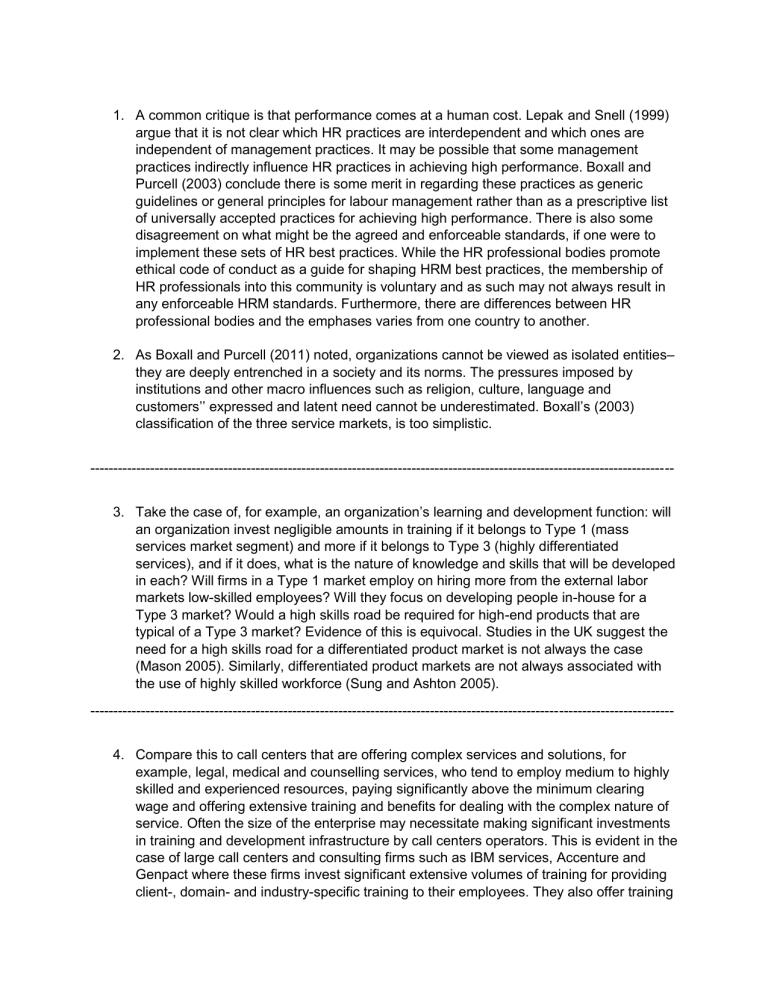HRM Practices & Organizational Performance Research
advertisement

1. A common critique is that performance comes at a human cost. Lepak and Snell (1999) argue that it is not clear which HR practices are interdependent and which ones are independent of management practices. It may be possible that some management practices indirectly influence HR practices in achieving high performance. Boxall and Purcell (2003) conclude there is some merit in regarding these practices as generic guidelines or general principles for labour management rather than as a prescriptive list of universally accepted practices for achieving high performance. There is also some disagreement on what might be the agreed and enforceable standards, if one were to implement these sets of HR best practices. While the HR professional bodies promote ethical code of conduct as a guide for shaping HRM best practices, the membership of HR professionals into this community is voluntary and as such may not always result in any enforceable HRM standards. Furthermore, there are differences between HR professional bodies and the emphases varies from one country to another. 2. As Boxall and Purcell (2011) noted, organizations cannot be viewed as isolated entities– they are deeply entrenched in a society and its norms. The pressures imposed by institutions and other macro influences such as religion, culture, language and customers’’ expressed and latent need cannot be underestimated. Boxall’s (2003) classification of the three service markets, is too simplistic. ------------------------------------------------------------------------------------------------------------------------------3. Take the case of, for example, an organization’s learning and development function: will an organization invest negligible amounts in training if it belongs to Type 1 (mass services market segment) and more if it belongs to Type 3 (highly differentiated services), and if it does, what is the nature of knowledge and skills that will be developed in each? Will firms in a Type 1 market employ on hiring more from the external labor markets low-skilled employees? Will they focus on developing people in-house for a Type 3 market? Would a high skills road be required for high-end products that are typical of a Type 3 market? Evidence of this is equivocal. Studies in the UK suggest the need for a high skills road for a differentiated product market is not always the case (Mason 2005). Similarly, differentiated product markets are not always associated with the use of highly skilled workforce (Sung and Ashton 2005). ------------------------------------------------------------------------------------------------------------------------------4. Compare this to call centers that are offering complex services and solutions, for example, legal, medical and counselling services, who tend to employ medium to highly skilled and experienced resources, paying significantly above the minimum clearing wage and offering extensive training and benefits for dealing with the complex nature of service. Often the size of the enterprise may necessitate making significant investments in training and development infrastructure by call centers operators. This is evident in the case of large call centers and consulting firms such as IBM services, Accenture and Genpact where these firms invest significant extensive volumes of training for providing client-, domain- and industry-specific training to their employees. They also offer training A. Malik 31 modules in the areas of cultural integration for a better person-organization fit. Other forms of training include, for example, Six Sigma training and certification at Genpact, which is a widely acknowledged strength of this offshore outsourcing major for bringing about process improvements and service excellence. Additional information: (Best Practice) There is a habit we have as people of homing in on the one reason why something succeeds or fails. The clearer and simpler an explanation, the more weight it tends to carry. It is the kind of analysis that brings kudos to newspaper columnists, post-match commentators, political pundits and, of course, people speaking in business meetings and board rooms. After all, if anyone can make this complicated ever-changing world clear and simple, they deserve our respect. Clear and simple is easy to communicate and it’s also easy to remember. But it has problems. We have all been sat in meetings listening to someone with deep experience carefully explaining their way through complex information, flagging the unknowns, only for them to be gazumped by someone entirely unburdened by actual knowledge but with their finger firmly planted on the pulse of an acceptable one-line answer. All heads are turned. It’s called the narrative fallacy. You have probably heard of it; it has been floating around the business world for years. Amazon founder Jeff Bezos is a big fan. Bestselling author Malcolm Gladwell has seemingly built a career out of exposing it. It’s the idea that we tend to create simple stories out of complex happenings around us and we become wedded to them.


